Aggregation Mechanism of Alzheimer’s Amyloid β-Peptide Mediated by α-Strand/α-Sheet Structure
Abstract
1. Introduction
2. Results
2.1. Occurrence of α-Strand Structure in Region 24–26
2.2. Transition of Dihedrals
2.3. Effect of Mutation on Occurrence of α-Strand Structure in Region 24–26
2.4. PDB Search for α-Strand Structure with VGS Sequence
3. Discussion
4. Materials and Methods
4.1. Structures of Human Aβ1–42 and Mutants
4.2. Molecular Dynamics Simulation
4.3. Computation of Dihedral Angles
4.4. PDB Search for α-Strand Structure
Author Contributions
Funding
Conflicts of Interest
References
- Citron, M. Alzheimer’s disease: Strategies for disease modification. Nat. Rev. Drug Discov. 2010, 9, 387–398. [Google Scholar] [CrossRef] [PubMed]
- LaFerla, F.M.; Green, K.N.; Oddo, S. Intracellular amyloid-β in Alzheimer’s disease. Nat. Rev. Neurosci. 2007, 8, 499–509. [Google Scholar] [CrossRef]
- Hardy, J.A.; Higgins, G.A. Alzheimer’s disease: The amyloid cascade hypothesis. Science 1992, 256, 184–186. [Google Scholar] [CrossRef] [PubMed]
- Aleksis, R.; Oleskovs, F.; Jaudzems, K.; Pahnke, J.; Biverstål, H. Structural studies of amyloid-β peptides: Unlocking the mechanism of aggregation and the associated toxicity. Biochimie 2017, 140, 176–192. [Google Scholar] [CrossRef] [PubMed]
- Hatami, A.; Monjazeb, S.; Milton, S.; Glabe, C.G. Familial Alzheimer’s disease mutations within the amyloid precursor protein alter the aggregation and conformation of the amyloid-β peptide. J. Biol. Chem. 2017, 292, 3172–3185. [Google Scholar] [CrossRef] [PubMed]
- Selkoe, D.J.; Hardy, J. The amyloid hypothesis of Alzheimer’s disease at 25 years. EMBO Mol. Med. 2016, 8, 595–608. [Google Scholar] [CrossRef] [PubMed]
- Karran, E.; Mercken, M.; De Strooper, B. The amyloid cascade hypothesis for Alzheimer’s disease: An appraisal for the development of therapeutics. Nat. Rev. Drug Discov. 2011, 10, 698–712. [Google Scholar] [CrossRef]
- Cummings, J.; Lee, G.; Mortsdorf, T.; Ritter, A.; Zhong, K. Alzheimer’s disease drug development pipeline: 2017. Alzheimers Dement. 2017, 3, 367–384. [Google Scholar] [CrossRef]
- Coric, V.; Salloway, S.; van Dyck, C.H.; Dubois, B.; Andreasen, N.; Brody, M.; Curtis, C.; Soininen, H.; Thein, S.; Shiovitz, T. Targeting prodromal Alzheimer disease with avagacestat: A randomized clinical trial. JAMA Neurol. 2015, 72, 1324–1333. [Google Scholar] [CrossRef]
- Doody, R.S.; Raman, R.; Farlow, M.; Iwatsubo, T.; Vellas, B.; Joffe, S.; Kieburtz, K.; He, F.; Sun, X.; Thomas, R.G. A phase 3 trial of semagacestat for treatment of Alzheimer’s disease. N. Engl. J. Med. 2013, 369, 341–350. [Google Scholar] [CrossRef]
- Salloway, S.; Sperling, R.; Fox, N.C.; Blennow, K.; Klunk, W.; Raskind, M.; Sabbagh, M.; Honig, L.S.; Porsteinsson, A.P.; Ferris, S. Two phase 3 trials of bapineuzumab in mild-to-moderate Alzheimer’s disease. N. Engl. J. Med. 2014, 370, 322–333. [Google Scholar] [CrossRef] [PubMed]
- Honig, L.S.; Vellas, B.; Woodward, M.; Boada, M.; Bullock, R.; Borrie, M.; Hager, K.; Andreasen, N.; Scarpini, E.; Liu-Seifert, H. Trial of solanezumab for mild dementia due to Alzheimer’s disease. N. Engl. J. Med. 2018, 378, 321–330. [Google Scholar] [CrossRef] [PubMed]
- Panza, F.; Seripa, D.; Lozupone, M.; Solfrizzi, V.; Imbimbo, B.P.; Barulli, M.R.; Tortelli, R.; Capozzo, R.; Bisceglia, P.; Dimitri, A. The potential of solanezumab and gantenerumab to prevent Alzheimer’s disease in people with inherited mutations that cause its early onset. Expert. Opin. Biol. Ther. 2018, 18, 25–35. [Google Scholar] [CrossRef] [PubMed]
- Sevigny, J.; Chiao, P.; Bussière, T.; Weinreb, P.H.; Williams, L.; Maier, M.; Dunstan, R.; Salloway, S.; Chen, T.; Ling, Y. The antibody aducanumab reduces Aβ plaques in Alzheimer’s disease. Nature 2016, 537, 50–56. [Google Scholar] [CrossRef]
- Shea, D.; Hsu, C.-C.; Bi, T.M.; Paranjapye, N.; Childers, M.C.; Cochran, J.; Tomberlin, C.P.; Wang, L.; Paris, D.; Zonderman, J. α-Sheet secondary structure in amyloid β-peptide drives aggregation and toxicity in Alzheimer’s disease. Proc. Natl. Acad. Sci. USA 2019, 116, 8895–8900. [Google Scholar] [CrossRef]
- Hopping, G.; Kellock, J.; Barnwal, R.P.; Law, P.; Bryers, J.; Varani, G.; Caughey, B.; Daggett, V. Designed α-sheet peptides inhibit amyloid formation by targeting toxic oligomers. Elife 2014, 3, e01681. [Google Scholar] [CrossRef]
- Maris, N.L.; Shea, D.; Bleem, A.; Bryers, J.D.; Daggett, V. Chemical and physical variability in structural isomers of an L/D α-sheet peptide designed to inhibit amyloidogenesis. Biochemistry 2017, 57, 507–510. [Google Scholar] [CrossRef]
- Armen, R.S.; DeMarco, M.L.; Alonso, D.O.; Daggett, V. Pauling and Corey’s α-pleated sheet structure may define the prefibrillar amyloidogenic intermediate in amyloid disease. Proc. Natl. Acad. Sci. USA 2004, 101, 11622–11627. [Google Scholar] [CrossRef]
- Daggett, V. α-Sheet: The toxic conformer in amyloid diseases? Acc. Chem. Res. 2006, 39, 594–602. [Google Scholar] [CrossRef]
- Bi, T.M.; Daggett, V. The role of α-sheet in amyloid oligomer aggregation and toxicity. Yale J. Biol. Med. 2018, 91, 247–255. [Google Scholar]
- Balupuri, A.; Choi, K.-E.; Kang, N.S. Computational insights into the role of α-strand/sheet in aggregation of α-synuclein. Sci. Rep. 2019, 9, 59. [Google Scholar] [CrossRef] [PubMed]
- Bleem, A.; Francisco, R.; Bryers, J.D.; Daggett, V. Designed α-sheet peptides suppress amyloid formation in Staphylococcus aureus biofilms. NPJ Biofilms Microbiomes 2017, 3, 16. [Google Scholar] [CrossRef] [PubMed]
- Paranjapye, N.; Daggett, V. De novo designed α-sheet peptides inhibit functional amyloid formation of Streptococcus mutans biofilms. J. Mol. Biol. 2018, 430, 3764–3773. [Google Scholar] [CrossRef] [PubMed]
- Armen, R.S.; Alonso, D.O.; Daggett, V. Anatomy of an amyloidogenic intermediate: Conversion of β-sheet to α-sheet structure in transthyretin at acidic pH. Structure 2004, 12, 1847–1863. [Google Scholar] [CrossRef]
- Maloney, J.A.; Bainbridge, T.; Gustafson, A.; Zhang, S.; Kyauk, R.; Steiner, P.; van der Brug, M.; Liu, Y.; Ernst, J.A.; Watts, R.J.; et al. Molecular mechanisms of Alzheimer disease protection by the A673T allele of amyloid precursor protein. J. Biol. Chem. 2014, 289, 30990–31000. [Google Scholar] [CrossRef]
- Lin, T.W.; Chang, C.F.; Chang, Y.J.; Liao, Y.H.; Yu, H.M.; Chen, Y.R. Alzheimer’s amyloid-β A2T variant and its N-terminal peptides inhibit amyloid-β fibrillization and rescue the induced cytotoxicity. PLoS ONE 2017, 12, e0174561. [Google Scholar] [CrossRef]
- Day, R.; Bennion, B.J.; Ham, S.; Daggett, V. Increasing temperature accelerates protein unfolding without changing the pathway of unfolding. J. Mol. Biol. 2002, 322, 189–203. [Google Scholar] [CrossRef]
- Melquiond, A.; Dong, X.; Mousseau, N.; Derreumaux, P. Role of the region 23–28 in Aβ fibril formation: Insights from simulations of the monomers and dimers of Alzheimer’s peptides Aβ40 and Aβ42. Curr. Alzheimer Res. 2008, 5, 244–250. [Google Scholar] [CrossRef][Green Version]
- Roychaudhuri, R.; Lomakin, A.; Bernstein, S.; Zheng, X.; Condron, M.M.; Benedek, G.B.; Bowers, M.; Teplow, D.B. Gly25-Ser26 amyloid β-protein structural isomorphs produce distinct Aβ42 conformational dynamics and assembly characteristics. J. Mol. Biol. 2014, 426, 2422–2441. [Google Scholar] [CrossRef]
- Roychaudhuri, R.; Huynh, T.-P.V.; Whitaker, T.R.; Hodara, E.; Condron, M.M.; Teplow, D.B. A critical role of Ser26 hydrogen bonding in Aβ42 assembly and toxicity. Biochemistry 2017, 56, 6321–6324. [Google Scholar] [CrossRef]
- Kobayashi, S.; Tanaka, Y.; Kiyono, M.; Chino, M.; Chikuma, T.; Hoshi, K.; Ikeshima, H. Dependence pH and proposed mechanism for aggregation of Alzheimer’s disease-related amyloid-β (1–42) protein. J. Mol. Struct. 2015, 1094, 109–117. [Google Scholar] [CrossRef]
- Tiiman, A.; Krishtal, J.; Palumaa, P.; Tõugu, V. In Vitro fibrillization of Alzheimer’s amyloid-β peptide (1–42). AIP Adv. 2015, 5, 092401. [Google Scholar] [CrossRef]
- Milner-White, J.E.; Watson, J.D.; Qi, G.; Hayward, S. Amyloid formation may involve α-to β sheet interconversion via peptide plane flipping. Structure 2006, 14, 1369–1376. [Google Scholar] [CrossRef] [PubMed]
- Hayward, S. Peptide-Plane flipping in proteins. Protein Sci. 2001, 10, 2219–2227. [Google Scholar] [CrossRef]
- Benilova, I.; Gallardo, R.; Ungureanu, A.A.; Castillo Cano, V.; Snellinx, A.; Ramakers, M.; Bartic, C.; Rousseau, F.; Schymkowitz, J.; De Strooper, B. The Alzheimer disease protective mutation A2T modulates kinetic and thermodynamic properties of amyloid-β (Aβ) aggregation. J. Biol. Chem. 2014, 289, 30977–30989. [Google Scholar] [CrossRef]
- Izuo, N.; Murakami, K.; Sato, M.; Iwasaki, M.; Izumi, Y.; Shimizu, T.; Akaike, A.; Irie, K.; Kume, T. Non-Toxic conformer of amyloid β may suppress amyloid β-induced toxicity in rat primary neurons: Implications for a novel therapeutic strategy for Alzheimer’s disease. Biochem. Biophys. Res. Commun. 2013, 438, 1–5. [Google Scholar] [CrossRef]
- Armen, R.S.; Daggett, V. Characterization of two distinct β2-microglobulin unfolding intermediates that may lead to amyloid fibrils of different morphology. Biochemistry 2005, 44, 16098–16107. [Google Scholar] [CrossRef]
- Armen, R.S.; Bernard, B.M.; Day, R.; Alonso, D.O.; Daggett, V. Characterization of a possible amyloidogenic precursor in glutamine-repeat neurodegenerative diseases. Proc. Natl. Acad. Sci. USA 2005, 102, 13433–13438. [Google Scholar] [CrossRef]
- Chen, G.F.; Xu, T.H.; Yan, Y.; Zhou, Y.R.; Jiang, Y.; Melcher, K.; Xu, H.E. Amyloid beta: Structure, biology and structure-based therapeutic development. Acta Pharmacol. Sin. 2017, 38, 1205–1235. [Google Scholar] [CrossRef]
- Hardy, J.; De Strooper, B. Alzheimer’s disease: Where next for anti-amyloid therapies? Brain 2017, 140, 853–855. [Google Scholar] [CrossRef]
- Chow, V.W.; Mattson, M.P.; Wong, P.C.; Gleichmann, M. An overview of APP processing enzymes and products. Neuromol. Med. 2010, 12, 1–12. [Google Scholar] [CrossRef] [PubMed]
- Roher, A.E.; Lowenson, J.D.; Clarke, S.; Woods, A.S.; Cotter, R.J.; Gowing, E.; Ball, M.J. Beta-Amyloid-(1-42) is a major component of cerebrovascular amyloid deposits: Implications for the pathology of Alzheimer disease. Proc. Natl. Acad. Sci. USA 1993, 90, 10836–10840. [Google Scholar] [CrossRef] [PubMed]
- Kayed, R.; Lasagna-Reeves, C.A. Molecular mechanisms of amyloid oligomers toxicity. J. Alzheimers Dis. 2013, 33, S67–S78. [Google Scholar] [CrossRef]
- Villalobos Acosta, D.M.Á.; Chimal Vega, B.; Correa Basurto, J.; Fragoso Morales, L.G.; Rosales Hernández, M.C. Recent advances by in silico and In Vitro studies of amyloid-β 1–42 fibril depicted a S-shape conformation. Int. J. Mol. Sci. 2018, 19, 2415. [Google Scholar] [CrossRef]
- Kazmirski, S.L.; Daggett, V. Non-Native interactions in protein folding intermediates: Molecular dynamics simulations of hen lysozyme. J. Mol. Biol. 1998, 284, 793–806. [Google Scholar] [CrossRef] [PubMed]
- Pauling, L.; Corey, R.B. The pleated sheet, a new layer configuration of polypeptide chains. Proc. Natl. Acad. Sci. USA 1951, 37, 251–256. [Google Scholar] [CrossRef]
- Grillo-Bosch, D.; Carulla, N.; Cruz, M.; Sánchez, L.; Pujol-Pina, R.; Madurga, S.; Rabanal, F.; Giralt, E. Retro-Enantio N-methylated peptides as β-Amyloid aggregation inhibitors. ChemMedChem 2009, 4, 1488–1494. [Google Scholar] [CrossRef]
- Meisl, G.; Yang, X.; Hellstrand, E.; Frohm, B.; Kirkegaard, J.B.; Cohen, S.I.; Dobson, C.M.; Linse, S.; Knowles, T.P. Differences in nucleation behavior underlie the contrasting aggregation kinetics of the Aβ40 and Aβ42 peptides. Proc. Natl. Acad. Sci. USA 2014, 111, 9384–9389. [Google Scholar] [CrossRef]
- Crescenzi, O.; Tomaselli, S.; Guerrini, R.; Salvadori, S.; D’Ursi, A.M.; Temussi, P.A.; Picone, D. Solution structure of the Alzheimer amyloid β-peptide (1–42) in an apolar microenvironment: Similarity with a virus fusion domain. Eur. J. Biochem. 2002, 269, 5642–5648. [Google Scholar] [CrossRef]
- Tomaselli, S.; Esposito, V.; Vangone, P.; van Nuland, N.A.; Bonvin, A.M.; Guerrini, R.; Tancredi, T.; Temussi, P.A.; Picone, D. The α-to-β conformational transition of Alzheimer’s Aβ-(1–42) peptide in aqueous media is reversible: A step by step conformational analysis suggests the location of β conformation seeding. ChemBioChem 2006, 7, 257–267. [Google Scholar] [CrossRef]
- Wälti, M.A.; Ravotti, F.; Arai, H.; Glabe, C.G.; Wall, J.S.; Böckmann, A.; Güntert, P.; Meier, B.H.; Riek, R. Atomic-Resolution structure of a disease-relevant Aβ (1–42) amyloid fibril. Proc. Natl. Acad. Sci. USA 2016, 113, E4976–E4984. [Google Scholar] [CrossRef] [PubMed]
- Abraham, M.J.; Murtola, T.; Schulz, R.; Páll, S.; Smith, J.C.; Hess, B.; Lindahl, E. GROMACS: High performance molecular simulations through multi-level parallelism from laptops to supercomputers. SoftwareX 2015, 1, 19–25. [Google Scholar] [CrossRef]
- Huang, J.; Rauscher, S.; Nawrocki, G.; Ran, T.; Feig, M.; de Groot, B.L.; Grubmüller, H.; MacKerell, A.D., Jr. CHARMM36m: An improved force field for folded and intrinsically disordered proteins. Nat. Methods 2017, 14, 71. [Google Scholar] [CrossRef] [PubMed]
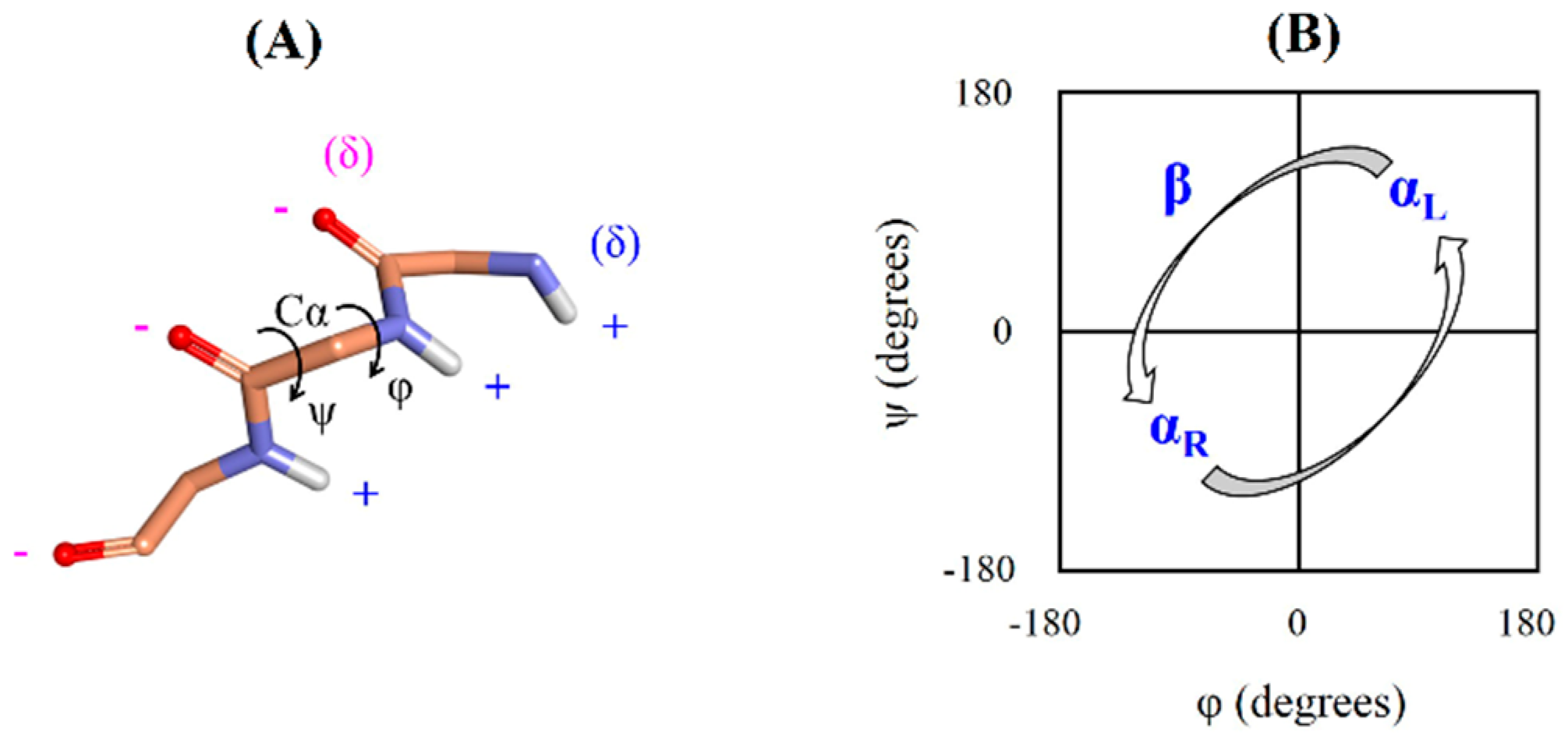
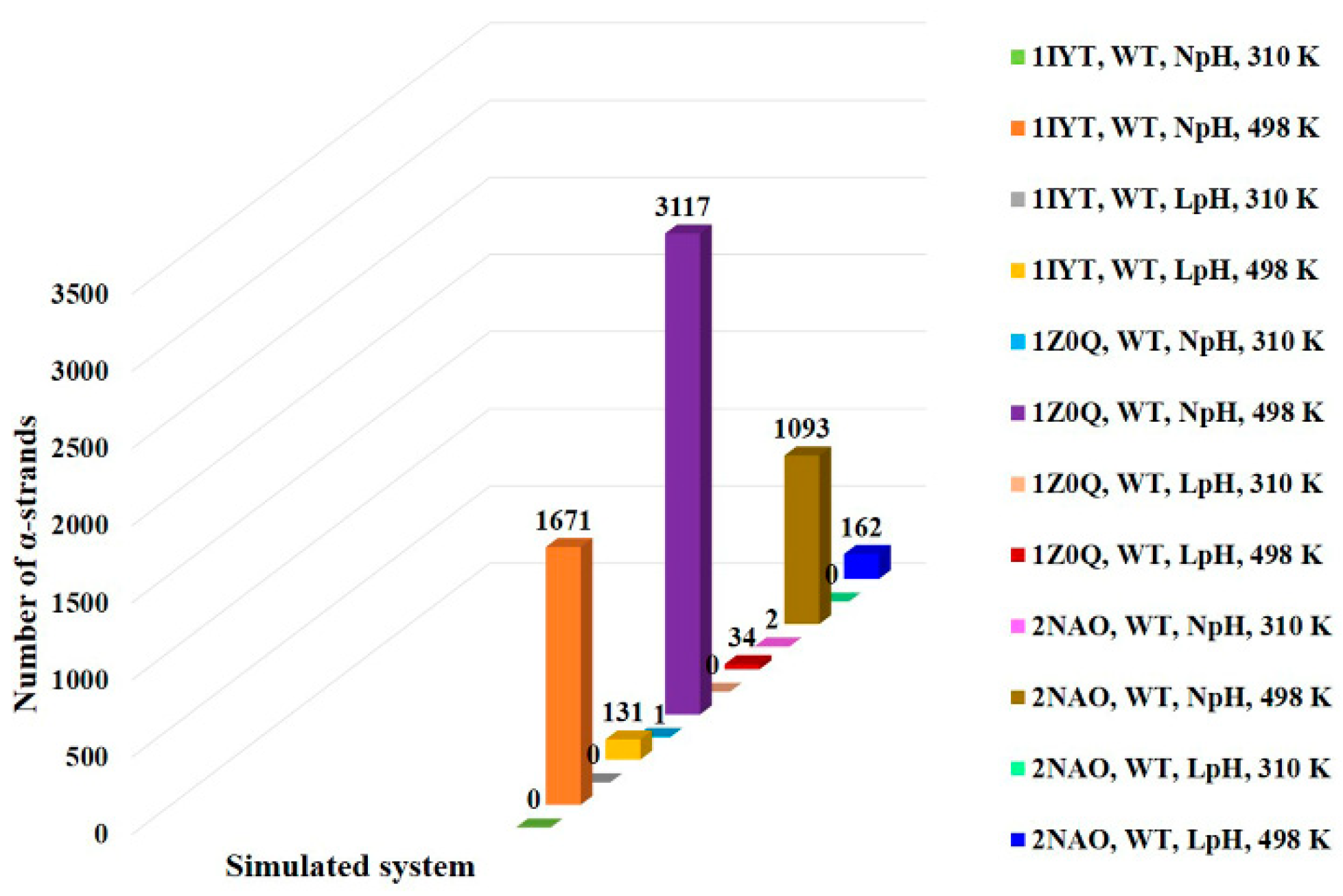
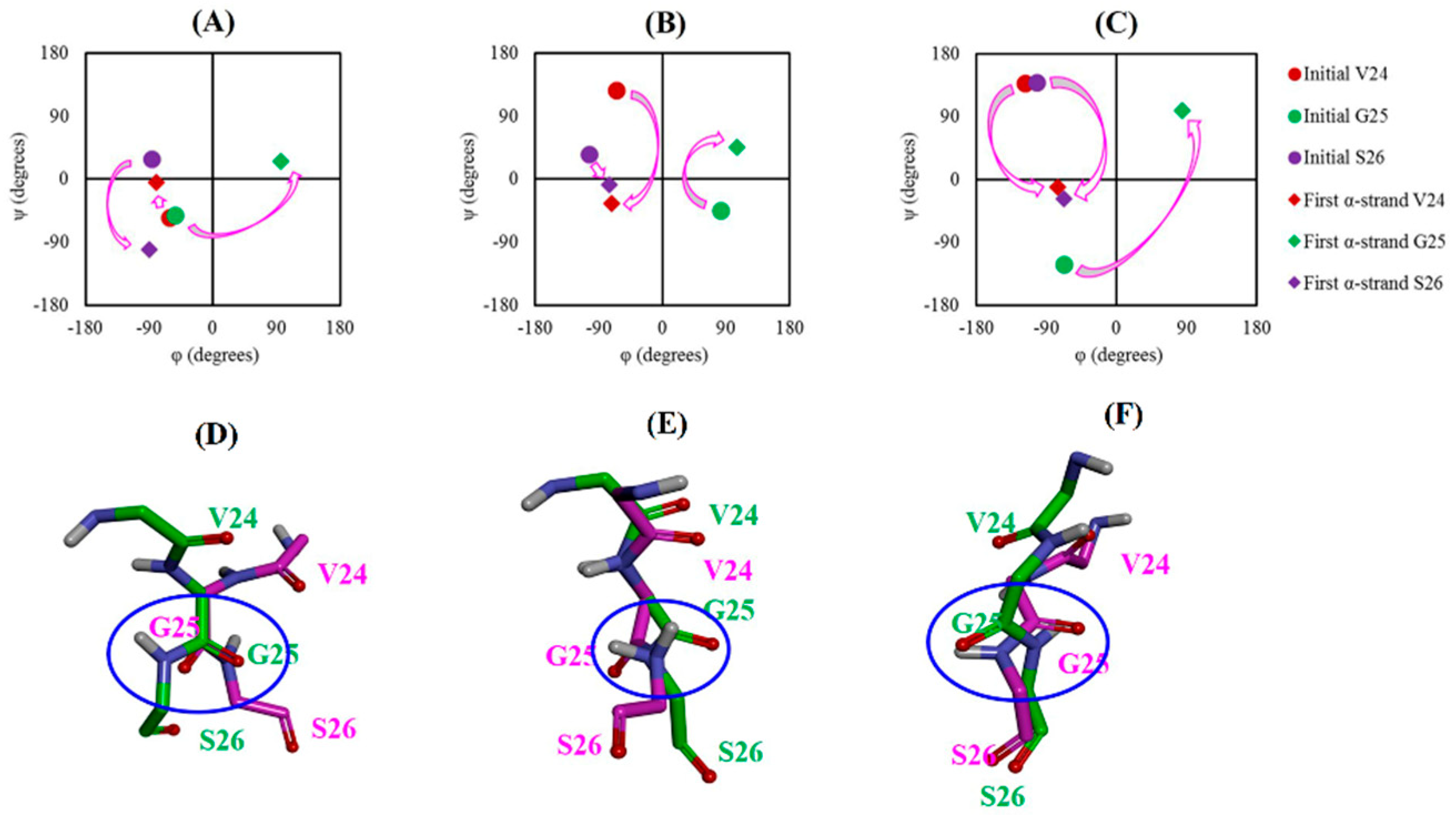
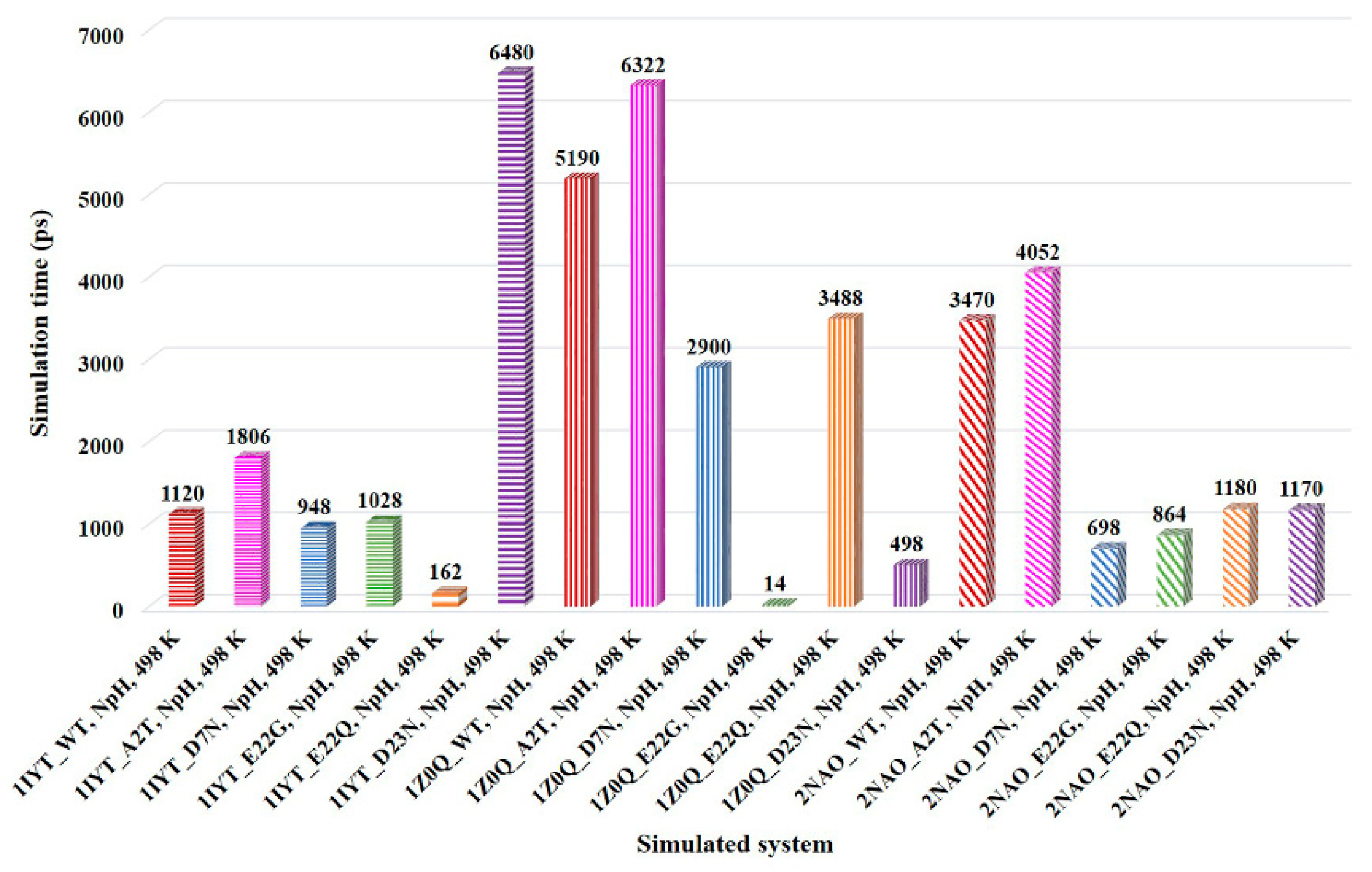
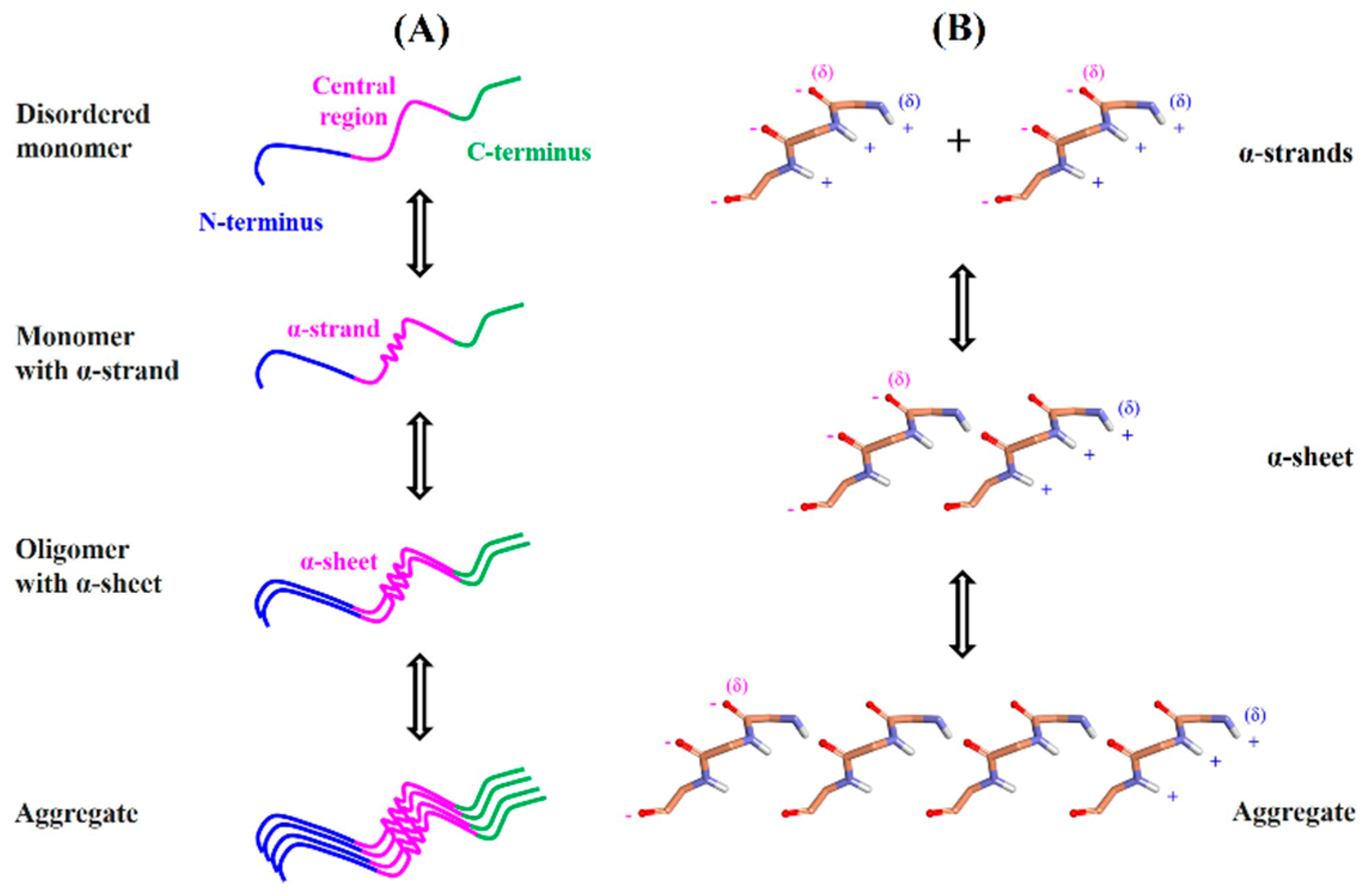

| Simulated System | PDB, Type | Counter Ion | Temperature | pH | MD Run |
|---|---|---|---|---|---|
| 1 | 1IYT, WT | 3 Na+ | 310 K | NpH | 50 ns |
| 2 | 1Z0Q, WT | 3 Na+ | 310 K | NpH | 50 ns |
| 3 | 2NAO, WT | 3 Na+ | 310 K | NpH | 50 ns |
| 4 | 1IYT, WT | 3 Na+ | 498 K | NpH | 50 ns |
| 5 | 1Z0Q, WT | 3 Na+ | 498 K | NpH | 50 ns |
| 6 | 2NAO, WT | 3 Na+ | 498 K | NpH | 50 ns |
| 7 | 1IYT, WT | 6 Cl− | 310 K | LpH | 50 ns |
| 8 | 1Z0Q, WT | 6 Cl− | 310 K | LpH | 50 ns |
| 9 | 2NAO, WT | 6 Cl− | 310 K | LpH | 50 ns |
| 10 | 1IYT, WT | 6 Cl− | 498 K | LpH | 50 ns |
| 11 | 1Z0Q, WT | 6 Cl− | 498 K | LpH | 50 ns |
| 12 | 2NAO, WT | 6 Cl− | 498 K | LpH | 50 ns |
| 13 | 1IYT, Mutant (A2T) | 3 Na+ | 498 K | NpH | 50 ns |
| 14 | 1Z0Q, Mutant (A2T) | 3 Na+ | 498 K | NpH | 50 ns |
| 15 | 2NAO, Mutant (A2T) | 3 Na+ | 498 K | NpH | 50 ns |
| 16 | 1IYT, Mutant (D7N) | 2 Na+ | 498 K | NpH | 50 ns |
| 17 | 1Z0Q, Mutant (D7N) | 2 Na+ | 498 K | NpH | 50 ns |
| 18 | 2NAO, Mutant (D7N) | 2 Na+ | 498 K | NpH | 50 ns |
| 19 | 1IYT, Mutant (E22G) | 2 Na+ | 310 K | NpH | 50 ns |
| 20 | 1Z0Q, Mutant (E22G) | 2 Na+ | 310 K | NpH | 50 ns |
| 21 | 2NAO, Mutant (E22G) | 2 Na+ | 310 K | NpH | 50 ns |
| 22 | 1IYT, Mutant (E22G) | 2 Na+ | 498 K | NpH | 50 ns |
| 23 | 1Z0Q, Mutant (E22G) | 2 Na+ | 498 K | NpH | 50 ns |
| 24 | 2NAO, Mutant (E22G) | 2 Na+ | 498 K | NpH | 50 ns |
| 25 | 1IYT, Mutant (E22Q) | 2 Na+ | 310 K | NpH | 50 ns |
| 26 | 1Z0Q, Mutant (E22Q) | 2 Na+ | 310 K | NpH | 50 ns |
| 27 | 2NAO, Mutant (E22Q) | 2 Na+ | 310 K | NpH | 50 ns |
| 28 | 1IYT, Mutant (E22Q) | 2 Na+ | 498 K | NpH | 50 ns |
| 29 | 1Z0Q, Mutant (E22Q) | 2 Na+ | 498 K | NpH | 50 ns |
| 30 | 2NAO, Mutant (E22Q) | 2 Na+ | 498 K | NpH | 50 ns |
| 31 | 1IYT, Mutant (D23N) | 2 Na+ | 498 K | NpH | 50 ns |
| 32 | 1Z0Q, Mutant (D23N) | 2 Na+ | 498 K | NpH | 50 ns |
| 33 | 2NAO, Mutant (D23N) | 2 Na+ | 498 K | NpH | 50 ns |
| 34 | 1IYT, Mutant (G25P) | 3 Na+ | 310 K | NpH | 50 ns |
| 35 | 1Z0Q, Mutant (G25P) | 3 Na+ | 310 K | NpH | 50 ns |
| 36 | 2NAO, Mutant (G25P) | 3 Na+ | 310 K | NpH | 50 ns |
| 37 | 1IYT, Mutant (G25P) | 3 Na+ | 498 K | NpH | 50 ns |
| 38 | 1Z0Q, Mutant (G25P) | 3 Na+ | 498 K | NpH | 50 ns |
| 39 | 2NAO, Mutant (G25P) | 3 Na+ | 498 K | NpH | 50 ns |
© 2020 by the authors. Licensee MDPI, Basel, Switzerland. This article is an open access article distributed under the terms and conditions of the Creative Commons Attribution (CC BY) license (http://creativecommons.org/licenses/by/4.0/).
Share and Cite
Balupuri, A.; Choi, K.-E.; Kang, N.S. Aggregation Mechanism of Alzheimer’s Amyloid β-Peptide Mediated by α-Strand/α-Sheet Structure. Int. J. Mol. Sci. 2020, 21, 1094. https://doi.org/10.3390/ijms21031094
Balupuri A, Choi K-E, Kang NS. Aggregation Mechanism of Alzheimer’s Amyloid β-Peptide Mediated by α-Strand/α-Sheet Structure. International Journal of Molecular Sciences. 2020; 21(3):1094. https://doi.org/10.3390/ijms21031094
Chicago/Turabian StyleBalupuri, Anand, Kwang-Eun Choi, and Nam Sook Kang. 2020. "Aggregation Mechanism of Alzheimer’s Amyloid β-Peptide Mediated by α-Strand/α-Sheet Structure" International Journal of Molecular Sciences 21, no. 3: 1094. https://doi.org/10.3390/ijms21031094
APA StyleBalupuri, A., Choi, K.-E., & Kang, N. S. (2020). Aggregation Mechanism of Alzheimer’s Amyloid β-Peptide Mediated by α-Strand/α-Sheet Structure. International Journal of Molecular Sciences, 21(3), 1094. https://doi.org/10.3390/ijms21031094





